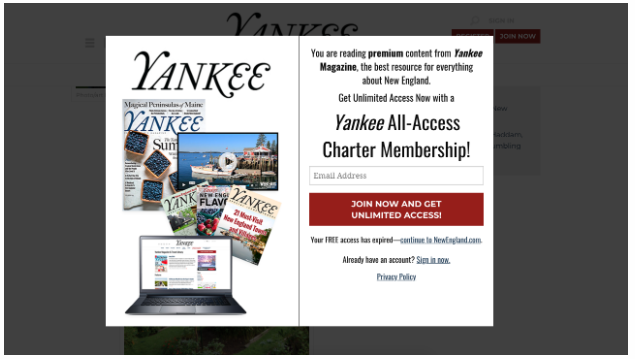When browsing around cyberspace, you may have stumbled across a website or two that requires you to sign up for a paid subscription to read the content. But is that a good business model?
In this guide, I’ll cover subscriptions and paywalls. I’ll also explain who they’re best suited for and how to optimize fee-based articles for search.
What You’ll Learn:
- The types of paywall
- How subscription models work
- How to make a successful paywall model
- Optimizing your content behind the paywall
What Is a Paywall?
First: what is a paywall?
The name sounds kind of ominous. But all it really means is that there’s some kind of value exchange for visitors to gain access to content.
Note: the value exchange doesn’t have to include money.
In other words, visitors don’t necessarily need to fork over cash just to get past a paywall and view the articles.
Instead, the person might offer something else of value, such as his or her email address. In that case, the webmaster uses the email address to build an email marketing list.
What About a “Metered” Paywall?
A metered paywall allows limited free access to the site during a period of time.
For example, you might visit the website of a prominent newspaper and notice a popup that reads: “This is the first article that you’re reading this month. You have access to four more articles for free.”

Yankee’s metered paywall allows three free premium articles per month, and each time you visit an article (source)
In that case, the metered paywall lets you read five articles for free every month. If you want to read a sixth article, you’ll have to subscribe.
What Is a Dynamic Paywall?
A dynamic paywall is a relatively new concept that’s based on the principle of personalized marketing.
Instead of offering a one-size-fits-all approach to the paywall model, a dynamic paywall identifies a visitor’s behaviors and interests and instead promotes a more relevant subscription.
As is the case with most examples of personalized marketing, the dynamic paywall approach enjoys a demonstrated history of success. Swiss newspaper Neue Zürcher Zeitung’s, for example, used it to increase subscriptions by a factor of five.
Of course, if you’re going to use a dynamic paywall with your website, you’ll need to collect lots of data on visitors. I’ll cover more on data collection later in the article.
What Is a Subscription?
A subscription model gives visitors access to all or part of a website, usually in exchange for a fee.

The New York Times is the global leader in the number of digital news subscriptions (source)
In some cases, a website offers access to exclusive content to subscribers, whereas the rest of site is accessible to all free of charge.
Other business models give subscribers access to content without ads.
How Much Are People Willing to Pay for Subscriptions?
Subscription rates vary. For media sites, visitors usually fork over around $3 per week.
Keep in mind, though: those are premium media organizations with well-known brand names that have lasted for decades.
It’s not likely you can set up a website and start charging for access to articles when nobody knows anything about your business.
That brings me to the risk of adopting a paywall.
The Risk
The general trend of the Internet is to offer information for free.
That means if you want to charge people for access to your content, it had better be unique, relevant, and very helpful.
News sites can get away with a paywall because they’re offering information that people often can’t get anywhere else. That’s especially the case if they get a scoop on breaking news.
But even some websites that offer very helpful info don’t charge a penny for access. One example is WebMD.
Think about that for a minute. If a website that offers helpful advice about people’s health doesn’t use the paywall model, then you know it’s a challenge to monetize content that way.
The simple fact is that most sites will have to settle for generating revenue with online ads.
Achieving Success With a Paywall: 5 Steps
If you do believe that your online content is paywall-worthy, then you’re going to need to follow some best-practices to achieve success. Fortunately, a recent study from media consultant group Blaize offers some helpful advice.
- Step one, take a page from the Marketing 101 playbook: identify your value proposition.
You need to give people a compelling reason to pay for access. To do that, you’ll have to highlight your unique selling proposition (USP) and promote it vigorously.
The Blaize study cites the example of the UK-based newspaper The Guardian. That company promoted the idea of free and independent journalism as its USP.
Did it work? Yep, the company received donations from 900,000 visitors across 170 countries.
That didn’t happen overnight, by the way. The Guardian marketed its brand for three years.
- Step two: apply advanced analytics to your paywall model.
“Advanced analytics is now key to acquisition, activation, and retention,” says Grzegorz Piechota, Researcher-in-Residence at INMA. “The future of paywalls will be based on data-driven insights.”
The Economist used a big data solution together with machine-learning software Lytics to generate predictive modeling. That’s how it created a personalized experience for each visitor.
That strategy led to an 80% decrease in customer acquisition costs and a three-fold increase in subscriptions.
Similarly, The Financial Times used an in-house solution to gauge visitor activity in terms of RFV (retention, frequency, and volume). The media site used insights from that data to deliver personalized recommendations.
The result: B2C visitors grew from 2% in 2016 to 54% in 2018.
- Step three to paywall success: organizational synergy.
Yes, that sounds like a phrase you’d only expect to see in Harvard Business Review, but it’s a very important concept if you expect people to pay for access to your content.
“Marketing, technology, advertising, content producers, and finance must all be aligned around a common set of goals and key performance metrics to successfully build a subscription product,” says Arvid Tchizhel, Senior Product Development Director at Mather Economics.
To make its case, the Blaize study cites Ben Cotton, Executive Director of Subscription Growth at The New York Times. According to Cotton, team members from editorial, engineering, design, and marketing all collaborate together to work on fixing problems.
Folks at The Guardian and The Economist also cite similar examples of cross-departmental teams working together on subscription-based content.
- Step four: implement the right technology.
What that means, in a nutshell, is this: identify your strategy first, then find the technology that fits the strategy.
Don’t do it the other way around!
Avoid any tech stack that requires you to sacrifice part of your strategy. Instead, find the solution that meets the needs of your business.
Integration is also important here. Make sure that your content management system, customer relationship software, paywall solution, web security, and shopping cart all play nicely together.
- Step five: make a good first impression.
It’s been said that you never have a second chance to make a good first impression. That’s never truer than when you want to sell content online.
According to the Blaize report, news websites that improved user experience have seen an increase in engagement and subscriptions.
Keep in mind, though: user experience isn’t just about making the website look nice. It’s also about usability.
The study cites an example of one website that reduced the “dozens of fields required for checkout down to five and observed the conversion rate grow 15% overnight.”
Finally, the FIPP Global Digital Subscription Snapshot 2019 study says that The Economist has the most subscriptions of any website in the digital magazine industry. So if you’re looking for an example to follow, that’s probably a great starting point.
Paywall Content and SEO
Just because you have content behind a paywall on your site doesn’t mean your pages can’t be optimized for search.
Indeed, you might want to leave some of your content open to all visitors as a way to “whet their appetites.” Then, they’ll be tempted to pay for a subscription when they see that your information is worth a price.
Fortunately, Google offers a set of guidelines that you can follow to ensure that your pages get indexed and the right snippets appear in the SERPs. You’ll need to implement a mix of CSS and Schema markup to make that happen.
Start With CSS
Web developers frequently use Cascading Style Sheets (CSS) to make websites look pretty and improve user experience. Google also says that you should use them to separate paywall content from non-paywall content.
Let’s say you have a great article that’s packed with valuable information about doubling the conversion rate on an ecommerce site. You want to “tease” visitors with a limited amount of valuable content so they’ll want to subscribe to your website.
In that case, use CSS to separate the paywall content from the teaser section. Here’s how you do that.
Do you see what’s going on there? The paywall content uses a CSS class called “paywall.” If people want to read anything in that section, they have to subscribe.
Add Some JSON-LD Structured Data
If you’re already familiar with Schema markup, then you know that there are two ways to add it to your website: with JSON-LD or with microdata. Since Google seems to love JSON-LD, I’ll show you how to add the markup in that format.
Most articles behind a paywall will fall under the CreativeWork type. Usually, though, you’ll want to get more specific than just identifying your article as CreativeWork.
Fortunately, there’s a child of CreativeWork called Article. That’s an ideal type for a web article about optimizing for conversions on an ecommerce site.
So to continue with the example above, here’s what your JSON-LD structured data would look like:
Pay close attention to the second half of that code. As you can see, there are a couple of elements that tell Google (and other search engines) that part of the content is behind a paywall.
But which part? The answer to that question is in the “cssSelector” attribute. That’s set to “.paywall.”
If you’re unfamiliar with CSS code, that period in front of the word “paywall” identifies a CSS class.
Now, go back to the HTML markup from the previous section and take a look at it. You’ll see that the last div element is identified by a class called “paywall.” That matches the “cssSelector” value in the JSON-LD structured data above.
What that all means is this: you’re telling the search engines that everything in the div element with the “paywall” class is premium content. People need to pay to see it.
The “hasPart” attribute is also important. That tells search engines that there’s a specific part of the article that requires special consideration. In this case, that portion of the article is the part that’s behind the paywall.
Wrapping It Up
You can generate revenue by putting a paywall on your website. However, your site would be the exception rather than the rule.
If you do want to set up a paywall, make sure you follow time-tested best-practices so that you won’t limit the reach of your brand and irritate potential customers while trying to increase top-line sales.
Then, finally, use CSS and schema markup to ensure that your paywall content is optimized for search.


